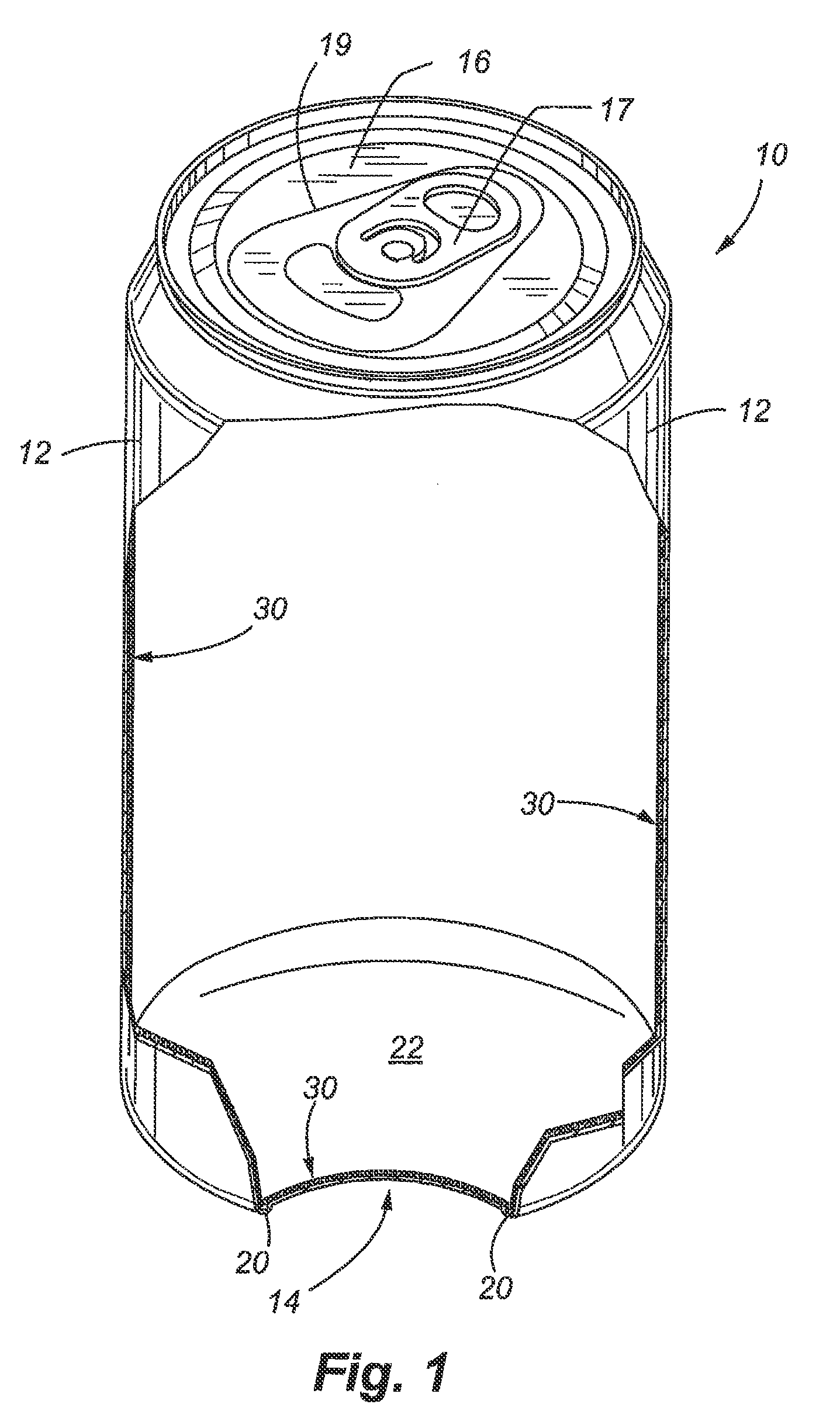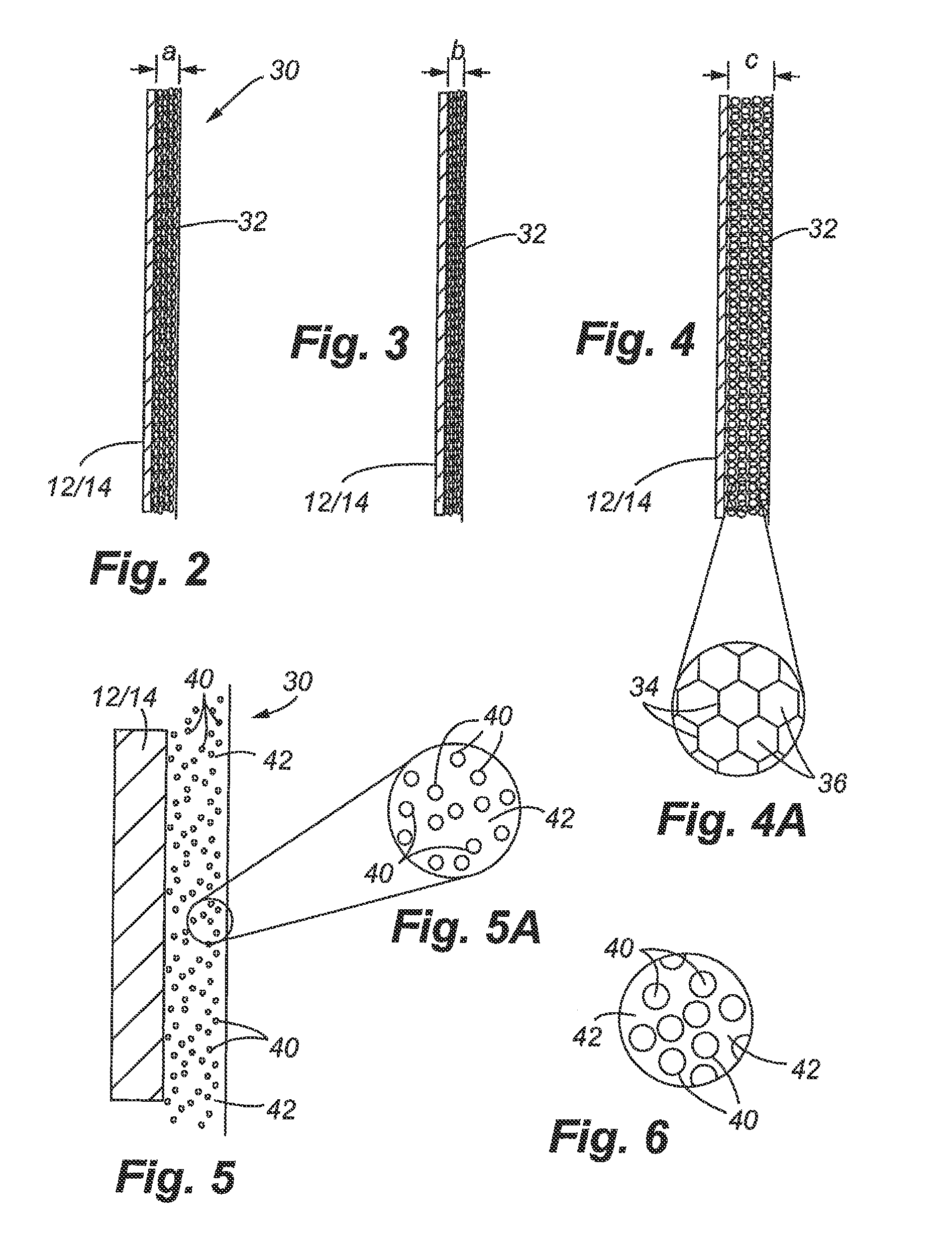Thermal barrier liner for containers
a container and thermal barrier technology, applied in the direction of rigid containers, railway components, packaging, etc., can solve the problems of undesirable or unfit consumption, traditional methods of insulating beverages, and the bottom of containers being exposed, so as to achieve the effect of effective and safe keeping beverages at the desired temperature during consumption
- Summary
- Abstract
- Description
- Claims
- Application Information
AI Technical Summary
Benefits of technology
Problems solved by technology
Method used
Image
Examples
third embodiment
[0100]FIGS. 7 and 7A specifically illustrate this third embodiment wherein the container is under pressure and assumedly at a chilled temperature (for example below 6° C.). FIG. 8 shows the container when removed from refrigeration and warmed to a temperature wherein the solid phase change material has transitioned from a solid to liquid state. More specifically, the materials in the microcapsules 50 are shown in FIGS. 7 and 8 as transitioning from a solid state 51 to a liquid state 52.
[0101]FIGS. 9, 9A and 10 illustrate yet another preferred embodiment of the present invention. In this embodiment, the thermal barrier liner 30 comprises multiple layers 60 of a lining material wherein voids or gaps 62 exist between each of the layers. The voids or gaps between the layers may be provided in an irregular pattern. Thus, the layers do not lie evenly over one another and the layers extend non-linearly having continuous patterns of bends or curves in the liner material that form the voids ...
first embodiment
[0106]With respect to a preferred thickness of the thermal barrier liner, it shall be understood that none of the embodiments are strictly limited to a specific range but it has been found that a liner between about 1.0 mm to 3.0 mm provides adequate insulation without displacing a quantity of the beverage that adversely affects desired headspace within the container. For the first embodiment, the thermal barrier liner can be between about 0.5 mm and 1.5 mm in thickness when the container is sealed and pressurized, and the thermal barrier liner expands to between about 1.0 mm and 3.0 mm when the container is opened and exposed to the environment.
[0107]For each of the embodiments of the present invention, it shall be understood that the thermal barrier liner 30 may be used as an additional layer applied to the interior surface of the container strictly for purposes of insulation, or may also serve as a combination of a conventional interior liner of the container to prevent undesirab...
second embodiment
[0123]Referring to FIG. 17, another embodiment of the present invention is illustrated wherein a cooling element 150 is a pouch or pocket having phase change material 148 therein. More specifically, the cooling element 150 may include an upper surface 156 formed from a first sheet of flexible plastic film and a lower surface 158 made from a second sheet of flexible plastic film. The two sheets of film material are sealed to one another along an exterior edge 154 of the pouch. In FIG. 17, a substantially rectangular shaped pouch is shown. However, it shall be understood that the pouch may be configured in many different shapes to include round, or even a donut shaped pouch that frictionally engages the sidewalls of the container. In this second embodiment, the use of a flexible pouch containing the phase change material is very adaptable for placement into many different types and shapes of containers. The pouch may be shaped and sized to best accommodate the type of container that i...
PUM
| Property | Measurement | Unit |
|---|---|---|
| temperatures | aaaaa | aaaaa |
| temperatures | aaaaa | aaaaa |
| transition temperature | aaaaa | aaaaa |
Abstract
Description
Claims
Application Information
 Login to View More
Login to View More - R&D
- Intellectual Property
- Life Sciences
- Materials
- Tech Scout
- Unparalleled Data Quality
- Higher Quality Content
- 60% Fewer Hallucinations
Browse by: Latest US Patents, China's latest patents, Technical Efficacy Thesaurus, Application Domain, Technology Topic, Popular Technical Reports.
© 2025 PatSnap. All rights reserved.Legal|Privacy policy|Modern Slavery Act Transparency Statement|Sitemap|About US| Contact US: help@patsnap.com



